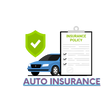Introduction
Auto insurance is a financial safety net designed to protect you from unexpected expenses stemming from accidents or vehicle-related incidents. However, the cost of your auto insurance premiums isn’t solely dependent on the type of coverage you choose. Your driving habits play a significant role in determining how much you pay for coverage. By understanding the relationship between your behavior on the road and your insurance costs, you can adopt habits that keep your premiums manageable.

Understanding the Link Between Driving Habits and Insurance Rates
Insurance companies assess risks when calculating premiums. To do this, they analyze data, including your driving record, accident history, and overall behavior on the road. Riskier driving habits often result in higher premiums because they indicate a higher likelihood of filing a claim.
Factors That Influence Your Insurance Premiums
1. Speeding and Aggressive Driving
Speeding and other forms of aggressive driving, such as tailgating or frequent lane changes, signal to insurers that you’re a high-risk driver. Not only do these behaviors increase the likelihood of accidents, but they can also result in tickets and violations that raise your premiums.
2. Distracted Driving
Distracted driving, such as using a smartphone while behind the wheel, is a growing concern for road safety. Insurers view drivers with records of distracted driving as higher-risk individuals, which can lead to increased premiums.
3. Consistent Adherence to Traffic Rules
Adhering to traffic laws and maintaining a clean driving record demonstrates that you are a responsible driver. Many insurance companies reward such behavior with safe driver discounts or reduced premiums.
Mileage Matters: How Much You Drive Affects Costs
The number of miles you drive annually directly impacts your insurance rates. More time on the road translates to greater exposure to risks. If you’re a high-mileage driver, you’re statistically more likely to be involved in an accident, which insurers consider when setting premiums.
Conversely, low-mileage drivers may qualify for discounts or pay-as-you-go insurance models that reward reduced risk exposure.
Regional Factors and Driving Habits
Where you live and drive can influence your premiums. For instance:
- Urban Areas: Drivers in densely populated regions often face higher rates due to increased traffic congestion and higher accident rates.
- Rural Areas: Fewer vehicles on the road generally mean fewer accidents, which can lead to lower premiums.
Accident History and Claims Frequency
If you’ve been involved in multiple accidents or filed several claims in the past, insurers may view you as a high-risk driver. This perception can lead to surcharges or even denial of certain policy benefits.
To mitigate these issues:
- Consider accident forgiveness programs offered by some insurers.
- Drive cautiously to avoid future incidents and establish a safer driving record.
The Role of Defensive Driving in Reducing Premiums
Enrolling in a defensive driving course can positively impact your insurance rates. These programs educate drivers on safe driving techniques, hazard recognition, and the importance of maintaining proper road etiquette. Successfully completing a course may lead to discounts and showcase your commitment to being a responsible driver.
Vehicle Maintenance and Its Indirect Impact
While vehicle maintenance isn’t directly linked to your driving habits, a poorly maintained car can increase the likelihood of accidents. For example:
- Worn brakes may lead to delayed stopping times.
- Faulty tires can compromise road grip and increase skid risks.
Keeping your vehicle in optimal condition not only ensures safety but can also contribute to fewer claims and stable premiums.
How Insurers Use Technology to Monitor Driving Habits
Many insurance companies now offer telematics-based programs that track driving behavior using apps or devices installed in your car. These programs monitor:
- Speed
- Braking patterns
- Acceleration
- Time of day you drive
Drivers exhibiting safe behaviors often receive rewards in the form of reduced premiums. However, reckless habits recorded through telematics can have the opposite effect.
Simple Steps to Improve Driving Habits and Save on Insurance
1. Stay Focused on the Road
Avoid distractions like texting or eating while driving.
2. Obey Speed Limits
Driving at a safe, consistent speed reduces accident risks and can improve your driving score.
3. Plan Routes in Advance
Minimizing unnecessary mileage helps keep costs down, especially if you qualify for mileage-based insurance.
4. Regularly Service Your Vehicle
Routine check-ups ensure your car is in peak condition, reducing the likelihood of breakdowns or accidents.
5. Take Advantage of Discounts
Ask your insurer about programs that reward safe driving or defensive driving course completion.
Conclusion
Your driving habits directly affect your auto insurance rates. By adopting safer practices and avoiding risky behaviors, you can not only protect yourself and others on the road but also enjoy significant financial benefits. Whether it’s by reducing mileage, maintaining a clean driving record, or leveraging technology to monitor your habits, proactive measures can make a tangible difference.

